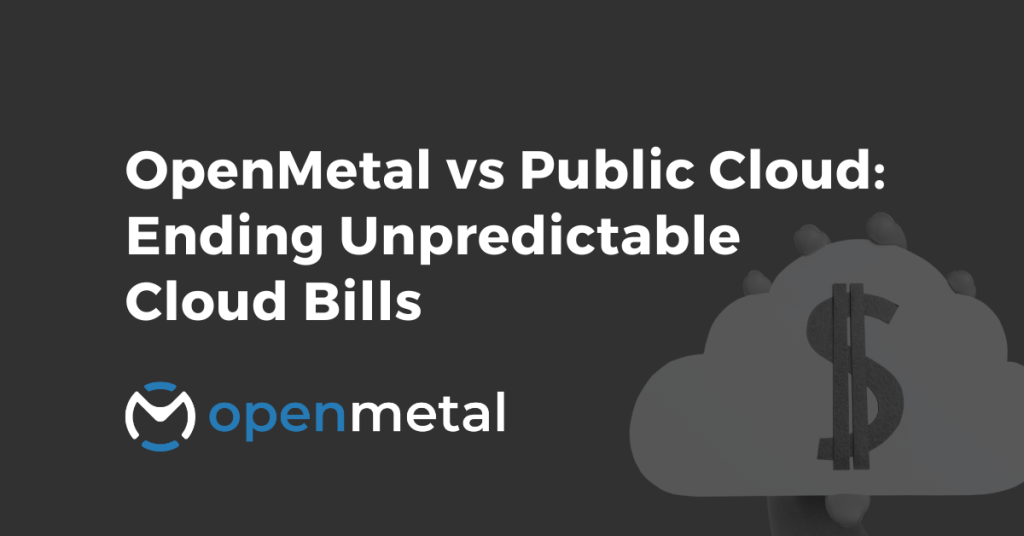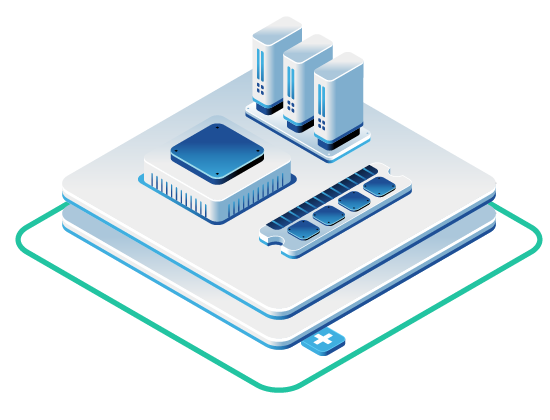
TL;DR: OpenMetal offers a radically transparent and fixed-cost private cloud pricing model that helps businesses escape the unpredictable, usage-based billing of public cloud providers. With a predictable monthly bill, no hidden licensing fees, and significantly lower egress costs, OpenMetal delivers 30-60% savings for organizations at scale.
This article compares both models and highlights why OpenMetal is a smarter, more strategic choice for long-term infrastructure needs.
The Continued and Rising Frustration with Public/Mega Cloud Costs
Many organizations are feeling sticker shock from public cloud bills. What often starts as a convenient pay-as-you-go model can turn into an accounting nightmare. Costs scale in opaque ways – a slight uptick in usage or data transfers can lead to unpredictable monthly bills that blow past budgets. In fact, industry research shows cloud spending continues to rise: one 2024 analysis noted a steady increase in cloud prices, even outpacing inflation. A survey by Flexera found that managing costs is the #1 cloud challenge, with roughly one-third of cloud spend being wasted on unused resources.
Andreessen Horowitz famously observed that at scale, public cloud “can at least double your infrastructure bill” compared to running your own hardware.
Some of the most common cost-related frustrations tech leaders cite with public clouds include:
Unpredictable Billing
Usage-based pricing can fluctuate wildly month to month, making it hard to forecast spend. Complex pricing models with thousands of SKUs often result in surprise charges that are difficult to trace.
Opaque Pricing Structures
Understanding true costs often requires navigating intricate calculators or engaging sales teams. Even then, the final bill may include hidden line items (like IOPS fees or regional data taxes) that weren’t obvious upfront.
Hidden Egress and Data Transfer Fees
While moving data into a public cloud (ingress) is usually free, getting data out (egress) is notoriously expensive. Major cloud providers charge $0.08–$0.12 per GB of outgoing traffic. For companies shifting large volumes (say hundreds of terabytes), egress fees alone can add tens of thousands of dollars – one report notes this can hit $80,000+ per month for high data users. These charges often feel like a “data tax” and can lock in customers due to the high cost of migrating away.
Proprietary Licensing Costs
If your cloud setup relies on proprietary software (such as VMware virtualization), you’re often paying hefty licensing fees on top of infrastructure costs. These fees can be substantial – on the order of $1k–$3.5k per processor plus additional costs per RAM block for VMware, as an example. Such licensing can quietly bloat your total cost of ownership in the public cloud.
It’s no surprise that many companies are reconsidering a one-size-fits-all public cloud strategy. Analysts suggest a more balanced approach – using on-premises or private clouds for steady workloads – to regain cost control. As Deloitte’s cloud chief put it, not every application belongs in a public cloud; a hybrid mix of on-prem, colocation, and other options can help keep costs in check. In this landscape, OpenMetal’s private cloud model emerges as a compelling alternative, designed explicitly to address many of these cost frustrations.
Questions? Schedule a meeting
Cloud Pricing Quick Comparison: OpenMetal vs Public Cloud
To help summarize the cost and strategic benefits outlined in this article, the following table provides a clear, side-by-side comparison of OpenMetal and traditional public cloud offerings.
| Feature / Cost Factor | OpenMetal | Public Cloud |
|---|---|---|
| Pricing Transparency | Public pricing calculator, no hidden fees | Publicly available pricing but often complex when pricing out full infrastructure needed |
| Monthly Cost Predictability | Fixed monthly cost for dedicated hardware | Variable and usage-based, hard to forecast |
| Bandwidth / Egress Fees | 95th percentile billing with generous included bandwidth | Per-GB egress fees, high cost for outbound data |
| Licensing Costs | Open-source stack, no hidden licensing fees | Licensing fees can add significant costs |
| Support and Migration Help | Ramp pricing, onboarding assistance, engineering support | Limited support without premium tiers, no ramp pricing |
| TCO at Scale | 30%-60% savings at $5K–$10K monthly usage and above | Costs can double vs. private cloud beyond usage threshold |
| Flexibility and Control | Customer chooses hardware, owns stack, open-source tools | Limited transparency, vendor lock-in, restricted control |
| Use Case Fit | Ideal for steady, long-term workloads | Best for short-term or unpredictable workloads |
Read on to discover how OpenMetal’s unique private cloud pricing model can give your business a unique competitive advantage.
Questions? Schedule a meeting
OpenMetal’s Transparent Private Cloud Pricing Model
OpenMetal delivers private cloud infrastructure as a service, but with a radically transparent and predictable pricing approach. It’s essentially a hosted OpenStack-powered cloud on dedicated hardware, offered with the ease of public cloud but without the billing surprises. Let’s break down how OpenMetal tackles each of the common pain points:
Public Facing Pricing
One refreshing aspect of OpenMetal is its publicly accessible Cloud Deployment Pricing Calculator. Anyone can go to OpenMetal’s website and configure a private cloud cluster to see exactly what it would cost – no gatekeeping or lengthy sales process required. This calculator lets you choose your hardware (number of servers, RAM, storage, etc.) and instantly provides a transparent cost estimate for that configuration. The pricing is fully itemized and clear, so you can experiment with different setups and understand the cost implications in real time.
This level of transparency is a stark contrast to many private cloud or enterprise cloud offerings where you have to speak to a salesperson to get a quote. With OpenMetal, the pricing tool is self-serve and up-front, empowering IT decision-makers to do early planning without commitment.
OpenMetal even allows setting budget thresholds (daily budgets for cloud clusters) to help with cost management and prevent overages. In short, the model is designed to eliminate surprises from the very first inquiry – you know what you’ll pay before you deploy a thing.
Fixed Hardware and Predictable Monthly Costs
OpenMetal’s pricing structure is built on fixed monthly costs for dedicated hardware resources, bringing predictability back to the budget. Instead of charging by the hour or by usage metrics, OpenMetal provides your own private cloud “cluster” for a flat monthly rate. You essentially get ownership over a set of hardware (three or more hyper-converged servers form an OpenMetal “Cloud Core” cluster) that is yours to use as needed. All the typical cloud components – compute, storage, networking – run on this dedicated cluster.
Because you’re paying for the hardware cluster, your bill doesn’t spontaneously spike due to usage bursts. Each month’s cost is predictable and stable, much like a colocation or hardware lease – but with OpenMetal handling the operations. As one customer case study noted, OpenMetal’s “transparent and fair hardware-based pricing” simplifies billing and makes expenses more predictable. There are no mysteries in the invoice: it’s a fixed service fee for the chosen infrastructure, not a laundry list of metered services.
This fixed-cost model addresses the “unpredictable billing” issue head-on. IT leaders can finally plan cloud costs on a spreadsheet years in advance, because a given cluster’s cost remains constant month to month (barring intentional additions of more resources). You won’t get budget-busting surprises because a dev team left some VMs running over the weekend. And if you do need to scale, you’ll add additional nodes – each with a known transparent price from the catalog – so growth is linear and controlled, not exponential.
No Hidden Egress Fees – 95th Percentile Bandwidth Billing
One of the most hated aspects of public clouds is the egress charge – every gigabyte that leaves the cloud comes with a fee. OpenMetal takes a dramatically different approach to bandwidth billing: 95th percentile billing with generous included transfer. Every OpenMetal private cloud cluster includes a substantial amount of data transfer in the base price. If you go beyond that included allotment, OpenMetal charges by bandwidth (in megabits per second) on a 95th percentile basis, not by total gigabytes transferred.
What does 95th percentile mean in practice? It means they measure your bandwidth usage over the month and ignore the top 5% of usage spikes. You’re billed based on the level at which your usage sat 95% of the time. This approach flattens out short bursts of high traffic – those sudden surges won’t blow up your bill. The result is more controlled and lower costs for data transfer, especially if your usage has peaks and valleys. OpenMetal reports that this leads to an egress cost advantage of up to 80% lower costs compared to the per-GB billing model of most public clouds. In the case of one customer migrating from Google Cloud, the bandwidth costs on OpenMetal were 50–80% less than GCP’s, contributing hugely to overall savings.
Perhaps most importantly, OpenMetal’s egress pricing is straightforward and fair – no more guessing games about how much data went out of which region at what rate. With a fixed bandwidth cost (and a high threshold before overages), organizations avoid the “hidden fee” nightmare that public cloud egress can become. For companies that serve lots of data to users or need to move backups out of the cloud, this can eliminate one of the biggest budget variables in cloud computing.
No Costly Licensing – Built on Open-Source Tech
OpenMetal’s platform is built on open-source foundations – namely OpenStack for cloud orchestration and Ceph for storage. Why does that matter for costs? Because it means you’re not paying for expensive proprietary software licenses (the kind that often accompany private clouds built on VMware, Microsoft, or other closed ecosystems). As OpenMetal emphasizes, open-source alternatives can “remove costly licensing fees” that would otherwise eat into your budget.
To put this in perspective, consider the typical licensing costs of VMware’s cloud stack: VMware fees can range from around $995 up to $3,495 per processor, plus additional charges of $615 to $1,950 per RAM block in some cases. These fees are essentially a tax on your cloud infrastructure just for the privilege of using proprietary software. In a public cloud environment or a managed private cloud built on VMware, those costs get passed along to you as the customer.
OpenMetal avoids this entirely by using open-source OpenStack and related tools. As noted in their cost guides, OpenMetal Cloud Cores leverage open tech to “minimize (or remove) licensing fees” and also avoid the vendor lock-in that comes with proprietary platforms. In short, you’re not paying a premium to third-party software vendors as part of your cloud bill. Every dollar is going toward infrastructure and support, not toward licensing line items. This dramatically improves cost-efficiency and is a key reason OpenMetal can offer lower prices for comparable private cloud capabilities.
For decision-makers, this means you don’t have to worry about rising software licensing costs or sudden contract changes from a vendor like VMware/Broadcom. Your private cloud is powered by community-driven software with no annual license renewals required – which aligns with the cost transparency ethos.
Discounts for Commitments and Migration Support
Cost predictability gets even better if you’re willing to make a term commitment. OpenMetal’s pricing has built-in discounts for longer agreements – similar in spirit to reserved instances but far more substantial in savings.
For example, the popular 3-server, Medium Cloud Core is about $3297/month for a 1 year term, but a 3 year term can bring it down to about $2888/month, and a 5-year term can drop it to roughly $2505/month. That’s up to a 36–47% discount for committing to a longer term. The principle is simple: if you plan to use the infrastructure for the long haul, OpenMetal rewards that commitment with lower effective rates. This can make OpenMetal’s private cloud even more cost-competitive over the lifetime of a project, turning cloud OPEX into something closer to a fixed depreciated cost.
OpenMetal also recognizes that moving from a public cloud to a private cloud can be a project in itself. To ease this transition, they offer a migration program with a Ramp Pricing model that ensures you don’t pay twice during migration. In other words, while you’re migrating workloads off your old cloud and onto OpenMetal, they can provide temporary pricing relief so that you’re not getting billed for two environments at once.
As OpenMetal puts it: “Don’t pay twice during the move process. Work with your account manager to get a move plan that fits.”.
This kind of ramp-up support is hugely beneficial for organizations that need a few months to switch over production systems. It eliminates the common scenario of double-paying (old provider + new provider simultaneously) which can deter cost-saving migrations.
Furthermore, OpenMetal’s team provides expert assistance during onboarding to optimize costs and performance from day one. They include engineering support to review your usage and even help re-architect for efficiency. The goal is not just to sell you infrastructure, but to ensure a smooth migration and cost optimization as you ramp up on the new platform. This contrasts with public cloud platforms where one might feel locked in despite rising costs – OpenMetal actively helps you escape those traps and hit the ground running.
Real-World Savings: 30-60% Cost Reductions in Case Studies
All the pricing model advantages discussed are not just theoretical – OpenMetal’s customers have reported eye-popping cost savings, often 50% or more, compared to their previous public cloud spend.
- For example, Convesio, a WordPress hosting platform provider, moved from Google Cloud to OpenMetal and cut their cloud costs by more than 50%. In detailed comparisons, Convesio saw about a 50% reduction versus GCP costs for equivalent workloads on a per-cluster basis. A big contributor was the bandwidth pricing difference (as noted earlier, OpenMetal’s egress costs were a fraction of GCP’s) as well as the elimination of waste and overhead. With over half of their infrastructure bill saved, Convesio could redirect budget to new business development initiatives – effectively turning cloud savings into fuel for growth.
- Another success story comes from a SaaS provider in the AI customer support space who migrated off AWS. Within the first six months of running on OpenMetal, this SaaS company saw cost savings of over 50% compared to AWS. Those savings weren’t marginal – they were able to reinvest that freed-up capital into new staff, resources, and product initiatives to accelerate their business. The switch to a private cloud with predictable costs not only cut their IT spend in half, but also gave them greater agility (no more worrying about surprise AWS bills for development and testing environments).
These are just two examples; OpenMetal’s case studies page highlights several organizations that have achieved 50%+ cloud cost reductions by moving workloads to its private cloud. Achieving such dramatic savings consistently is a strong validation of OpenMetal’s pricing approach. It shows that for the right use cases – typically those running at scale or with steady resource needs – a hosted private cloud can outperform public cloud on cost while still delivering cloud-like flexibility. The key is that OpenMetal stripped away the waste, the surprise fees, and the licensing overhead that plagues “mega cloud” providers. What’s left is lean, transparent infrastructure pricing that often translates to spending half as much for the same or better performance.
Questions? Schedule a meeting
OpenMetal: A Viable Alternative Amid Rising Cloud Costs
The backdrop to all this is a broader industry shift. After years of “cloud-first” mandates, many tech decision-makers are now taking a more nuanced view – especially as public cloud costs climb year over year. We’re seeing a trend toward hybrid and private cloud models, driven in part by cost control needs. Gartner’s reports note an increase in enterprises repatriating certain workloads to private clouds or on-premises data centers once spend reaches a tipping point. The reason is clear: at a certain scale, owning or dedicating infrastructure (whether on-prem or hosted private) can be far more cost-efficient. As one report put it, cloud isn’t automatically optimal for every workload and smart companies will align each workload with the most cost-effective environment.
Public cloud providers themselves have acknowledged customer pushback on costs – offering saving plans, reserved instances, and complex discount programs to try to rein in bills. But these often add more complexity. Despite such measures, 71% of organizations still expect their public cloud spend to keep increasing year over year. Clearly, the conventional public cloud pricing model isn’t getting cheaper or simpler at the macro level. This is why alternatives like OpenMetal are gaining attention.
OpenMetal positions its solution as “the best of traditional public cloud, private cloud, and bare metal, fused into an open source platform,” yielding “significant cost savings of 50% or more over traditional cloud options.”
For organizations grappling with ballooning AWS/Azure bills, OpenMetal offers a way to regain control and transparency. You get the agility and on-demand nature of cloud but in an environment where costs are fixed and knowable. No more guessing games or faith-based budgeting – you can literally open a pricing calculator and see your costs upfront for a private cloud that’s ready in minutes.
Moreover, the predictability and openness of OpenMetal’s pricing instill confidence that as you scale usage, you won’t be ambushed by proportional cost explosions. If anything, your unit costs go down with term discounts and efficient use of resources. And because it’s based on open-source, you’re insulated from vendor-driven price hikes (like a VMware license increase or a public cloud suddenly raising egress rates). It’s a model built for transparency and long-term stability.
The Tipping Point: When OpenMetal Becomes the Smart Financial Move
As Todd Robinson, OpenMetal’s co-founder, often highlights, “The tipping point happens when a business’s steady-state usage reaches the point where the public cloud’s pay-as-you-go convenience turns into cost inefficiency.”
For most organizations, this tipping point is reached when:
- Monthly public cloud bills regularly exceed $5,000–$10,000
- Bandwidth usage is highly variable or exceeds a few terabytes monthly
- Environments are stable (e.g., production, SaaS, or long-term dev/test workloads)
- VMware or other proprietary licensing costs are part of the mix
At that scale, OpenMetal’s fixed-cost private cloud—often with 50%+ savings—outperforms public cloud in both predictability and total cost of ownership. As usage grows, so does the value of fixed pricing. This isn’t just a lift-and-shift replacement—it’s a reset of the economic equation of cloud.
In Todd Robinson’s words: “We built OpenMetal for the moment when cloud needs stop being temporary and start being strategic.”
Conclusion: Regaining Cost Control with OpenMetal
For tech decision-makers under pressure to optimize budgets, OpenMetal’s private cloud is a persuasive alternative to the status quo of public cloud billing woes. It directly addresses the biggest cost frustrations: offering clear pricing up front, flat monthly costs for dedicated hardware, no surprise fees (thanks to fair 95th percentile bandwidth billing and included resources), and no proprietary license costs siphoning money away. The availability of steep term discounts and a supportive migration program further smooth the path toward savings.
In a world where public cloud costs are rising and often unpredictable, OpenMetal provides an anchor of stability and transparency. Organizations that have made the switch are seeing infrastructure bills cut in half or better, without sacrificing performance or flexibility. Those kind of results are hard to ignore. With industry trends pointing toward hybrid cloud adoption to tame costs, OpenMetal’s model is well-aligned with what forward-thinking IT leaders are seeking: cloud convenience with data-center-like cost control.
In summary, if your team is feeling the pain of opaque, ever-growing public cloud invoices, it may be time to evaluate a different approach. OpenMetal’s pricing model proves that cloud infrastructure can be delivered as a service without the mystery and margin of mega-cloud pricing. The combination of publicly documented pricing, fixed costs, open-source efficiencies, and customer-first policies makes OpenMetal a viable and transparent alternative for organizations hit by rising public cloud costs. The next time you forecast your IT budget and cringe at your cloud line item, remember – there is another way, and it might just save you 50% or more while ending the era of unpredictable cloud bills.
Questions? Schedule a meeting
Interested in the OpenMetal IaaS Platform?
Hosted Private Cloud
Day 2 ready. No licensing costs. Delivered in 45 seconds. Powered by enterprise open source tech.
Bare Metal Servers
High end bare metal server hosting for virtualization, big data, streaming, and much more.
Consult with Our Team
Meet our experts to get a deeper assessment and discuss your unique IaaS requirements.


































